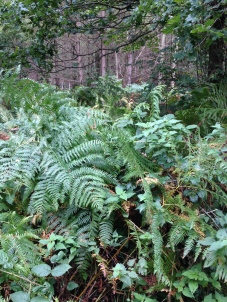 Any walk, well-taken, is full of hints and echoes, whispers if what was and what might be. The woods of Stow Bedon and Brecks of Thompson Common are hardly on the wild side, yet I walked for over two hours and saw just three human souls. Bracken, the British fern, stretched under oak and birch. Crows hunted and jays cracked while in occasional gardens smaller birds sang as if spring was still here. An enormous orange hornet on the path wrestled with a stick like a determined terrier. Angry dogs with grey round their muzzles guarded drowsy farms and the serried barns of pigs. I found blackberries and Bishop-Barnabies, and lots of spiny cases but no conkers. (I am looking for conkers as I g
Any walk, well-taken, is full of hints and echoes, whispers if what was and what might be. The woods of Stow Bedon and Brecks of Thompson Common are hardly on the wild side, yet I walked for over two hours and saw just three human souls. Bracken, the British fern, stretched under oak and birch. Crows hunted and jays cracked while in occasional gardens smaller birds sang as if spring was still here. An enormous orange hornet on the path wrestled with a stick like a determined terrier. Angry dogs with grey round their muzzles guarded drowsy farms and the serried barns of pigs. I found blackberries and Bishop-Barnabies, and lots of spiny cases but no conkers. (I am looking for conkers as I g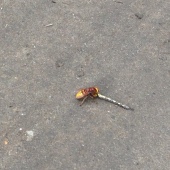 ather spiders avoid them, a useful tip this year for arachnophobes, though the science is dodgy.)
ather spiders avoid them, a useful tip this year for arachnophobes, though the science is dodgy.)
It is softly haunted, this empty bit of Norfolk. The Stanford battle area is named after the village evacuated in the middle of the second war, with the promise of return in 1945. It’s still deserted, the by-law signs mouldering while the keep-out barriers are bright. As I walked, RAF Tornados were dropping bombs in Iraq. I wondered if soldiers would suddenly converge on the track, exploding out of the woodland hu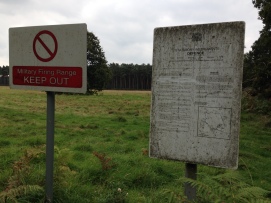 sh. Moments later, I saw movement among the trees; two camouflaged men were passing quietly, looking out towards the Common. They sketched a wave at me and disappeared.
sh. Moments later, I saw movement among the trees; two camouflaged men were passing quietly, looking out towards the Common. They sketched a wave at me and disappeared.
Part of my walk was on Peddar’s Way, an ancient path to the coast which has inspired artists to make a series of Songline works, telling the story of the route. I drank tea sitting by the modern standing stone whose writing is already illegible. Empty though the route is, these woods are worked, with hazel coppiced neatly and wood piled into witches’ bonfires. I met a woman out with her friendly dog. We chatted about her photography for the British Trust for Ornithology and the evidence of nuthatches busy in the trees. When I looked back down the straight path behind me, she had vanished.
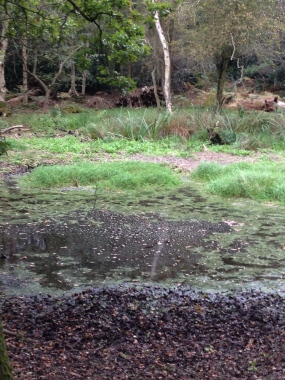 The ghosts are older than war. Pleistocene ponds litter the woodland, small pingos formed by melting ice when the glaciers retreated. Fairy lakes, glistening in sunlight filtered through leaves, harbouring forgotten monsters in the dark, shallow water left over from one hundred-thousand years of winter. My path meandered through the lakes, under woods and the occasional sheep-scattered field. I walked with the feeling that something might be watching.
The ghosts are older than war. Pleistocene ponds litter the woodland, small pingos formed by melting ice when the glaciers retreated. Fairy lakes, glistening in sunlight filtered through leaves, harbouring forgotten monsters in the dark, shallow water left over from one hundred-thousand years of winter. My path meandered through the lakes, under woods and the occasional sheep-scattered field. I walked with the feeling that something might be watching.
The guidebook instructed me to cross a sluggish stream and from the bridge I realised the busy inhabitants of the woods were not interested in me at all. To them I was the ra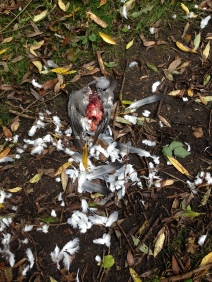 ttling shadow which would disappear, leaving no sign behind.
ttling shadow which would disappear, leaving no sign behind.
Death was not seeking me in the woods, but nonetheless reminded me of my place. I found a marker on the path, blood still red and seeping.


Beautiful. Thank you for sharing your walks. I love the sketch a wave line. x
Lovely. I felt like I was there with you.
Hi Sarah,
Lovely to read about your walk incorporating one of our Norfolk Trails. We would love to share your experience with others on our blog if you would give us permission to ‘reblog’ your post?!
Thanks for your kind words and please reblog (with credit). I willb e writing up yesterday’s amble around Upton Fen and the Bure shortly too.
Thank you Sarah! We look forward to reading and sharing what you get up to on your next ramble.
Pingback: Finding the right boots: success! - Sailing to Antarctica